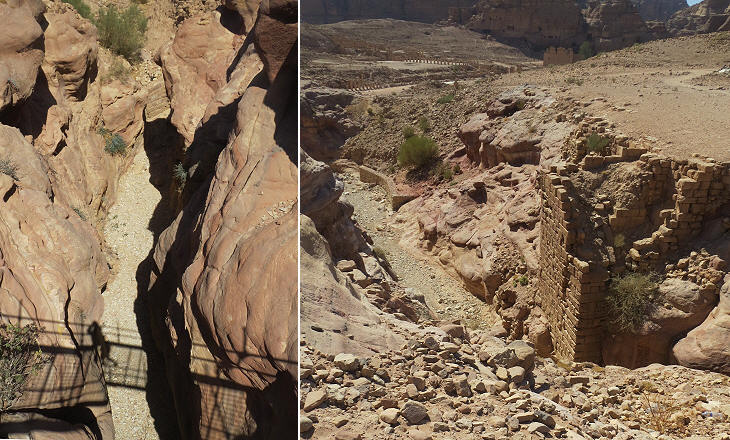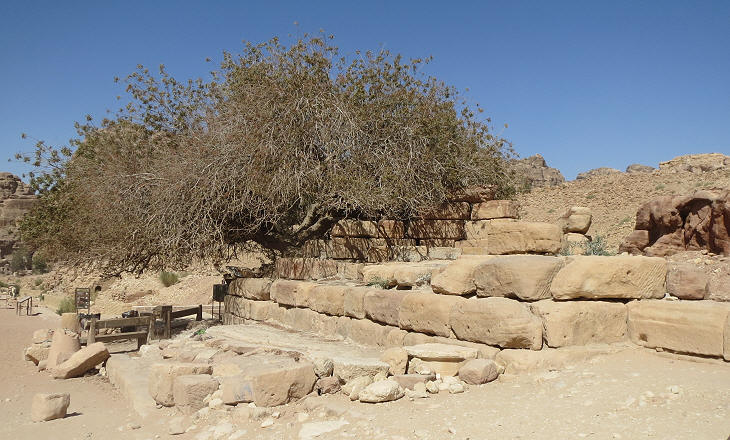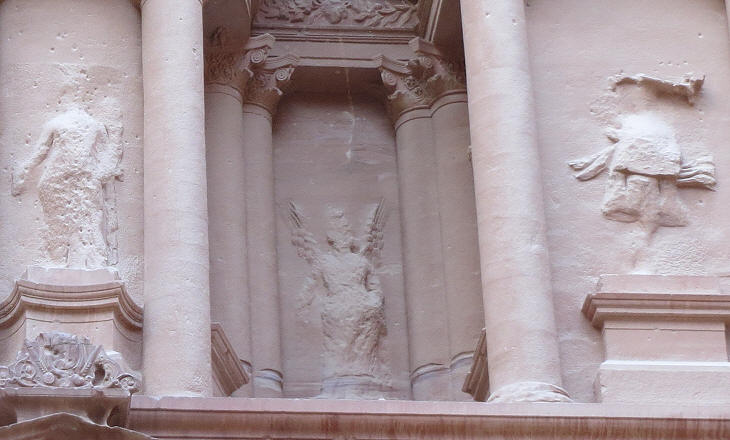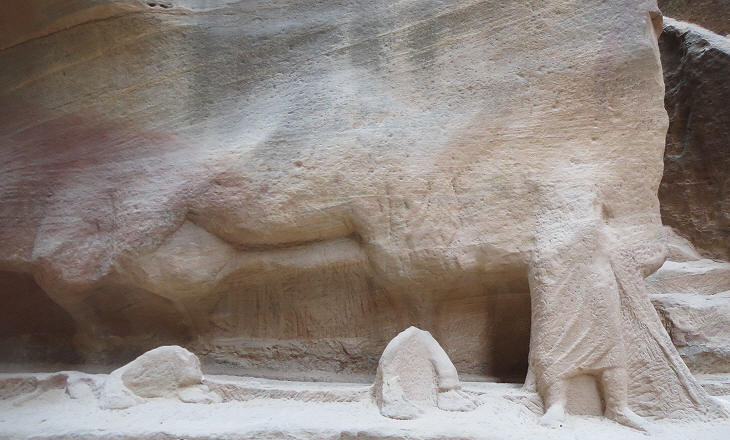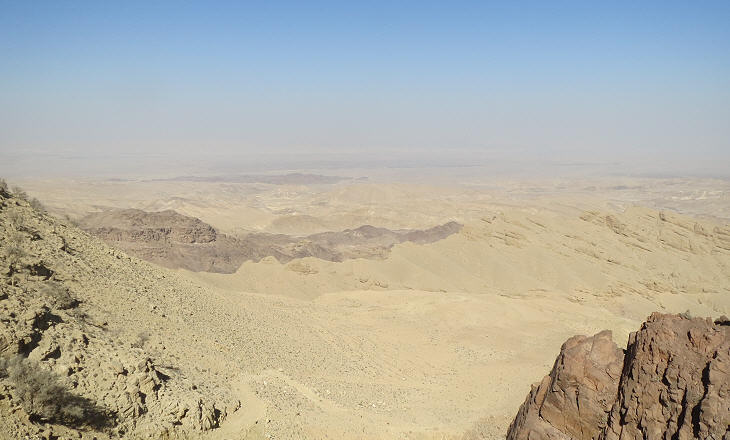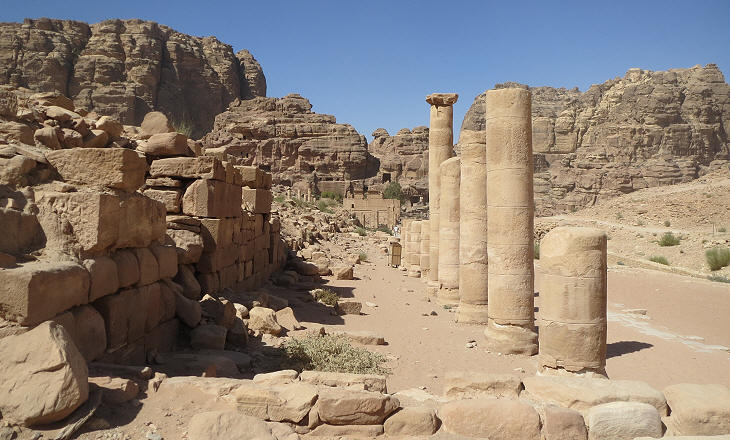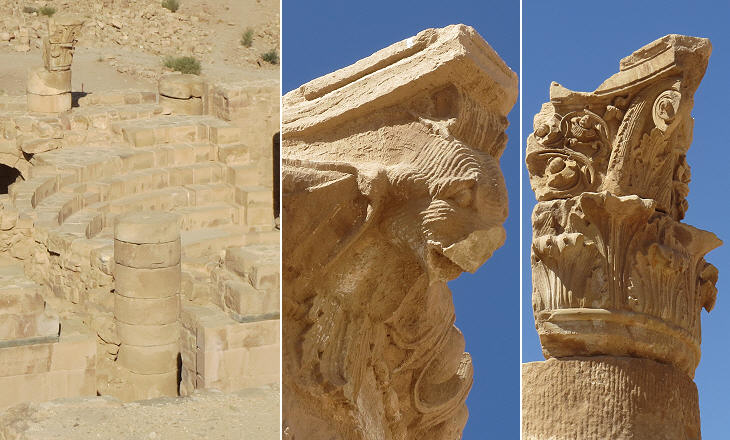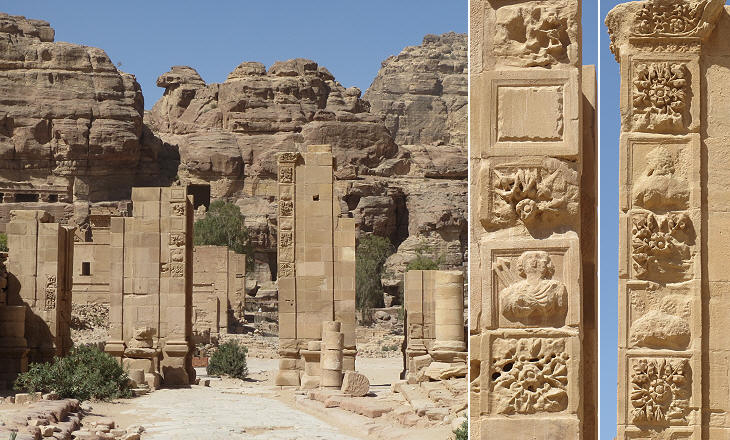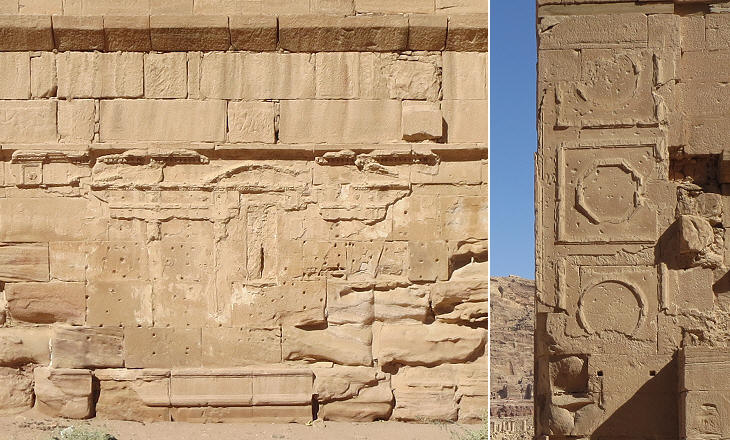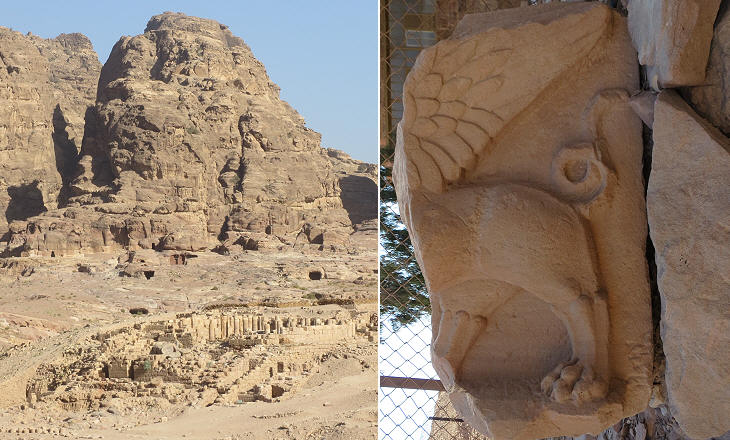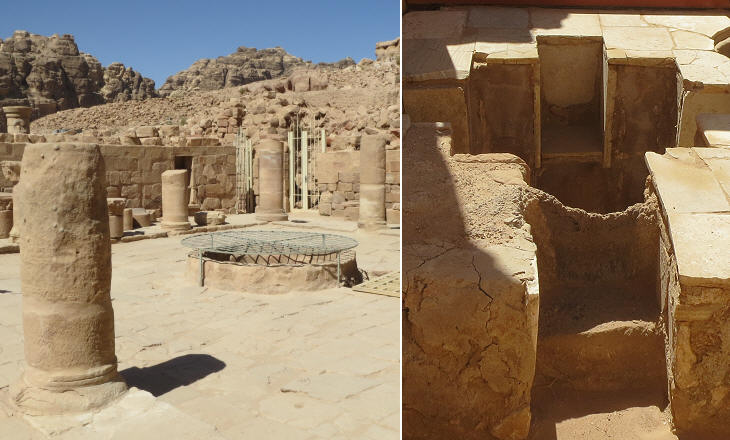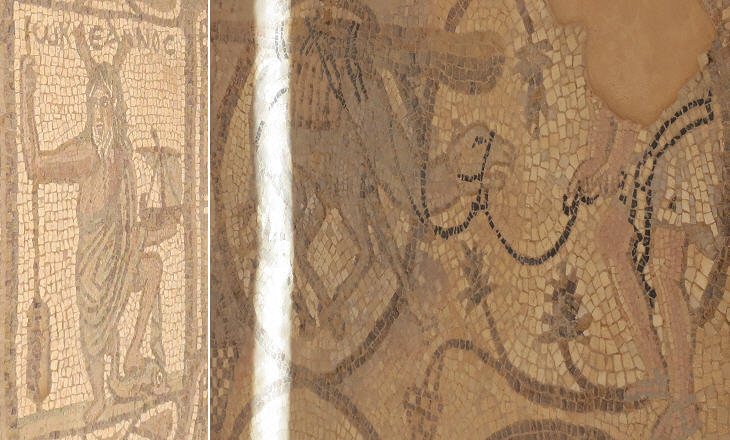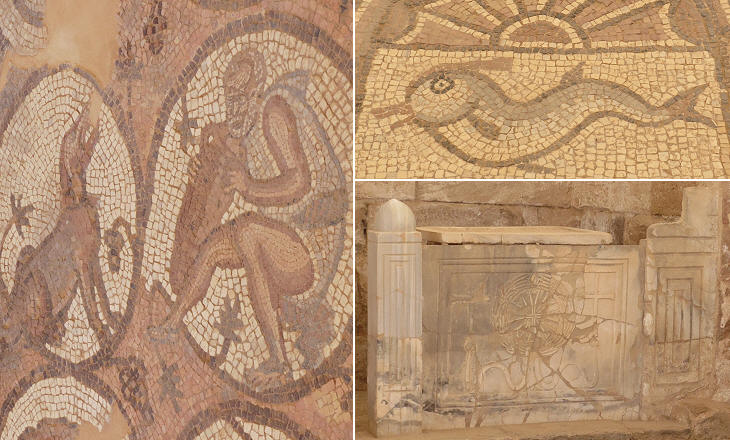  What's New! Detailed Sitemap All images © by Roberto Piperno, owner of the domain. Write to romapip@quipo.it. Text edited by Rosamie Moore. Page added in November 2013. |
 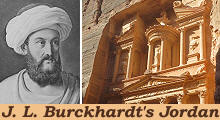 - Petra in Burckhardt's account - notes: part two - Petra in Burckhardt's account - notes: part two
(left: J. L. Burckhardt in Arab attire in a XIXth century engraving; right: the Treasury of Petra) If you came to this page directly you might wish to read J. L. Burckhardt's account of his visit to Petra first or notes: part one. The Syk: Street or River Bed
The Syk recalls Al-Fajj, a similar narrow passage at Maaloula in southern Syria. Burckhardt noticed a stone pavement in this passage which he believed had been built to favour the transit of the Wady Mousa stream. At the time of his journey it was very evident that the stream ran across the Syk, although because of the season (end of August) the passage was dry. Archaeologists have come to the conclusion that water was diverted from the Syk by excavating a side tunnel at the beginning of the Syk. They also believe that the channels at the sides of the Syk were conduits carrying water to the parts of the town which were no longer supplied by the stream.
The water flowed through Uadi al-Matahah, another gorge, and it eventually reached the plain where the town is situated. The dating of this undertaking is uncertain. It surely coincided with a period of great wealth for Petra such as the Ist century AD, however the engineering skills required to control the flow of water suggest the diversion was made after Emperor Trajan annexed the Nabatean Kingdom in 106 AD. The construction of roads, aqueducts and other facilities was part of a Roman policy aimed at winning the support of their new subjects.
At the point where Uadi al-Matahah joined the old river bed, immediately before the town, the Romans built a large public fountain, most likely as a monument to the completion of the diversion of the stream. Dating Petra
The lack of inscriptions and other historical sources has led archaeologists to suggest a wide range of dates for the Treasury, the most interesting monument of Petra. They cover a period from the Ist century BC to 131 AD when Emperor Hadrian visited Petra and added his name to that of the town. It makes sense to believe that the Treasury was built after the stream had been diverted from the Syk because the building has underground halls. The overall design of the monument would have pleased Francesco Borromini, one of the greatest architects of Baroque Rome whose works were inspired by the study of the ruins of Villa Adriana, the suburban residence of the emperor. The Treasury recalls S. Carlo alle Quattro Fontane (it opens in a separate window) by Borromini.
Burckhardt had no time to closely study the reliefs of the Treasury which, in the lack of inscriptions, are the only clues to the purpose and dating of the monument. He thought that one of the two reliefs in the lower part of the building portrayed a woman on a camel, but there is now general consensus that they represent Castor and Pollux, two demigods of the Greek pantheon, whom the Romans regarded as protectors of their city. According to many sources the female figure at the centre of the upper part represents Isis holding a cornucopia with her left hand and a sistrum, a musical instrument, with her right hand. Other sources suggest the female figure to be Tyche, a goddess who protected towns or a Nabatean goddess. The winged helmet however could be associated with Rome. The denarius, a widely used Roman silver coin, often had a head of Rome with a winged helmet on one side and Castor and Pollux on the other one (as you can see in the image used as background for this page). The Treasury could have been a monument to Rome erected at the request of Hadrian. The other reliefs portray Victories and Amazons and are consistent with this theory. A Trading City
The wealth of Petra was based on trade and two camel caravans (incoming and outgoing) were depicted in real size reliefs in the Syk. In the last period of the Nabatean kingdom the importance of trade probably diminished because the last king moved his residence to Bosra, in today's southern Syria, at the centre of a rich farming region.
The Syk was the entrance to Petra from the south-east. Caravans exited the town at its north-western end and after a few miles they left the mountainous region surrounding Petra to descend towards Wady Arabah, a valley which stretches from Aqaba on the Red Sea to the Dead Sea. Today it looks a very desolate area with a landscape marked only by the different colours of the rocks. In ancient times however the site was not as barren as it is today. Caravans crossed Wady Arabah to reach Oboda and Mamfis, Nabatean towns in today's Israel, and eventually the ports of the Mediterranean Sea. The Town
The extent of the monumental area of the town is rather small when compared to that over which the tombs are spread. When Burckhardt visited the site he could only establish by the number of broken stones that a town was there. Today archaeologists have been able to identify cardo maximus, the main north-south street of the town and to re-erect some of the columns which flanked it.
Archaeologists from Brown University, Rhode Island, USA have worked at the reconstruction of a temple built on terraces on the western side of cardo. It covers a large area and it was utilized as a church.
The deities to whom the temple was dedicated have not been identified yet and the dating of the monument is a matter for discussion. Brown University archaeologists set its enlargement in the Ist century AD.
The Colonnaded Street ended with a monumental gate which has been partially reconstructed and associated with Emperor Hadrian, although evidence is very limited. The association is mainly based on the fact that many towns visited by the emperor erected celebratory arches (e.g. Antalya and Jerash).
Kasr Bent Faraoun was the only standing building Burckhardt saw. It is believed to have been a temple dedicated to Dushara, a local god who was eventually associated with Zeus. A cubical stone was worshipped inside the large cella.
The part of the town to the east of the Colonnaded Street (and of Wady Mousa) is still to be fully investigated by archaeologists. A temple named after some reliefs found on the site was probably dedicated to a Nabatean goddess. Christian Petra
Archaeologists have found a church built in the Vth century and subsequently enlarged at a short distance from the Temple of the Winged Lion. The overall complex was made up of the church, a square courtyard with porticoes and a small building housing a full-immersion baptismal font.
The main nave had a marble floor, whereas the side naves were decorated with mosaics. They do not depict many Christian symbols and following a traditional pattern they portray Oceanus, a pagan personification of the river which encircled the world. You may wish to see an astonishing mosaic portraying Oceanus at Antioch.
Archaeologists have found and reconstructed a pluteus or transennae, a marble parapet which (with others) indicated the area of the church reserved to priests. It was made in Constantinople and it is similar to those which embellish S. Clemente in Rome and identical to one in the Museum of Israel. Return to notes - part one or to Burckhardt's account or move to: Introductory Page Ajlun Castle and Pella (May 3rd, 1812) Amman and its environs (July 7th, 1812) Aqaba "Castles" in the Desert (incl. Qasr el-Azraq) Jerash (May 2nd, 1812) Madaba (July 13th, 1812) Mt. Nebo and the Dead Sea (July 14th, 1812) On the Road to Petra (incl. Kerak and Showbak) (July 14th - August 19th, 1812) Umm al-Jimal Umm Qays (May 5th, 1812)  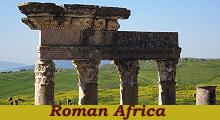 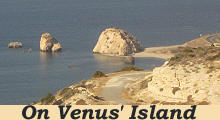 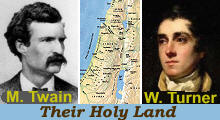
|

